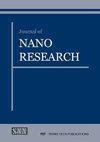高性能α-Bi2O3/CdS异质结光催化剂:创新设计、电化学性能和DFT计算
IF 1
4区 材料科学
Q4 MATERIALS SCIENCE, MULTIDISCIPLINARY
引用次数: 2
摘要
异质结半导体光催化技术是一种清除水中有机污染物的好方法,在光催化领域具有重要的应用价值。本文采用电泳沉积法制备α-Bi2O3/CdS型-Ⅱ异质结光催化剂。PL、Raman和EIS结果表明,α-Bi2O3/CdS中存在异质结效应,有利于提高光生电子-空穴对的分离效率。DFT计算表明,CdS的功函数(4.57 eV)高于α-Bi2O3的功函数(3.37 eV),这有利于e-从α-Bi2O3的CB向CdS的CB迁移,h+从CdS的VB向α-Bi2O3的VB迁移,从而保留了具有高氧化还原能力的e—h+对。在模拟可见光照射下,通过降解甲基橙(MO)、酸性品红来评价其性能。在模拟可见光照射下,BC45复合材料4 h的降解效率最高,分别为87% (MO)和81%(酸性品红),比cd (MO)和(酸性品红)高约2倍。认为与单一CdS和α-Bi2O3相比,α-Bi2O3/CdS复合材料具有H2O润湿性和染料吸附性能的双重特性,促进了光催化过程。该研究为开发高效的α-Bi2O3/CdS复合光催化剂提供了新的思路。本文章由计算机程序翻译,如有差异,请以英文原文为准。
High-Performance α-Bi2O3/CdS Heterojunction Photocatalyst: Innovative Design, Electrochemical Performance and DFT Calculation
Heterojunction semiconductor photocatalysis is an auspicious technique for clear up organic pollutants from water, and have been of valuable strategy in the area of photocatalysis. Herein, electrophoretic deposition procedure was used to prepare α-Bi2O3/CdS type-Ⅱ heterojunction photocatalysts. The results of PL, Raman, and EIS show that there is a heterojunction effect in α-Bi2O3/CdS, which is propitious to improve the separation efficiency of photogenerated electron-hole pairs. The DFT calculation reveals that the work function of CdS (4.57 eV) is higher than that of α-Bi2O3 (3.37 eV), which facilitates the migrating of e- from the CB of α-Bi2O3 to the CB of CdS, and the migrating of h+ from the VB of CdS to the VB of α-Bi2O3, thus the e--h+ pairs with high redox ability are retained. The performances were assessed by degrading methyl orange (MO), acid magenta under simulated visible light irradiation. Under simulated visible light irradiation, BC45 composite exhibited the highest degradation efficiency of 87% (MO) and 81% (acid fuchsin) for 4 h, which was about 2 times higher than that of CdS (MO) and (acid fuchsin). It is believed that the dual characteristics of H2O wettability and dye adsorption performance in α-Bi2O3/CdS composites promote photocatalytic process compared with single CdS and α-Bi2O3. The study could provide new insights to develop efficiently capable photocatalysts of the α-Bi2O3/CdS composites.
求助全文
通过发布文献求助,成功后即可免费获取论文全文。
去求助
来源期刊

Journal of Nano Research
工程技术-材料科学:综合
CiteScore
2.40
自引率
5.90%
发文量
55
审稿时长
4 months
期刊介绍:
"Journal of Nano Research" (JNanoR) is a multidisciplinary journal, which publishes high quality scientific and engineering papers on all aspects of research in the area of nanoscience and nanotechnologies and wide practical application of achieved results.
"Journal of Nano Research" is one of the largest periodicals in the field of nanoscience and nanotechnologies. All papers are peer-reviewed and edited.
Authors retain the right to publish an extended and significantly updated version in another periodical.
 求助内容:
求助内容: 应助结果提醒方式:
应助结果提醒方式:


